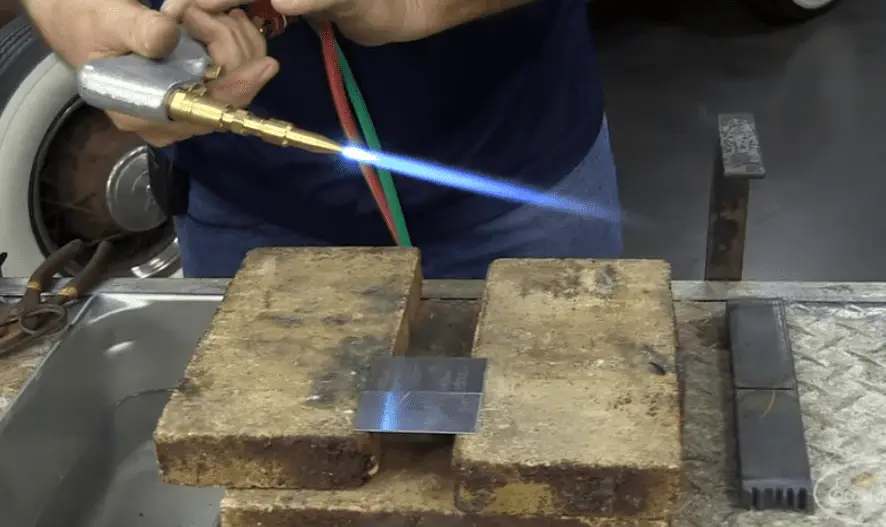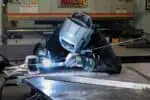Because of its strength, lightweight and corrosion resistant nature, aluminum is a common metal used in welding.
Many applications necessitate the connecting of aluminum, and welding is frequently the method of choice. Then there are several welding procedures that may be used to connect aluminum, the most common ones are-
-
-
- Gas Tungsten Arc Welding (GTAW) or TIG
- Gas Metal Arc Welding (GMAW) or MIG
-
While welding aluminum involves a lot of factors, there are additional elements that must be considered. Shielding gas is one of the most crucial. In some cases, shielding gas can affect the width of the bead as well as the depth of penetration.
Argon and helium are two shielding gases that are often used for arc welding aluminum. These gases are used as pure argon, pure helium, and different argon/helium mixes.
Importance of shielding gas
Shielding gases have long been used by welders to safeguard their work.
If you’re a welder, you should be familiar with these gases and how they’re used in welding. They are utilised on all job sites and in all welding projects.
As we are aware of various gases present in the environment that are detrimental to various metals. These gases are considered toxic to the metals and they impact the overall integrity of the welding.
These gases like oxygen, carbon dioxide and nitrogen contaminate the metal and that is why shielding gases are used to protect metals from contamination and oxidation.
They also have an influence on critical aspects of the welding process:
• The shielding gas frequently has a significant impact on the productivity and quality of welding.
• It protects the solidifying molten weld from oxygenation as well as airborne contaminants and moisture.
• Protects the metal from deterioration and increases the weld’s corrosion resistance.
• The shielding gas also helps to keep the welding gun cool.
So why does aluminum need shielding gas?
When welding aluminum, shielding gas is required. Gas suppliers frequently observe that the choice of gas is influenced by simplicity of use, heat-input requirements, and pricing.
Aluminum’s thermal conductivity is such that bigger or heavier portions need a strong heat input to connect the metal correctly.
Many welders choose to add helium to their standard shielding gas, such as 100% argon.
The addition of helium compels the constant-current power source to give additional voltage, which causes heat to be generated. Except for the cost of the shielding gas, this works pretty well.
Because helium is more expensive than argon, substantial increases such as 50% or even 75% helium content become prohibitively expensive.
Inert gases- Argon and Helium.
Inert gases are normally colorless, odorless, and tasteless gases that are non-flammable. In nature, inert gases are called inert because they are non-reactive, which means they do not react with any other element to generate a new chemical complex.
Argon (Ar)
Argon is a byproduct of the air-reduction processes used to make oxygen, accounting for about 1% of the total volume of air. This gas is effective for shielding welds in flat positions and deep grooves.
Argon is ideal for simpler starters, alternating current applications, and longer arcs at lower voltages. Argon is frequently used in pure form with aluminum and nonferrous metals.
Helium increases the heat transmission capabilities of argon, while mixing argon with carbon dioxide or oxygen can assist stabilise the arc.
When welding aluminum, magnesium, or titanium, 100% argon is commonly used because it makes a steady arc, offers consistent weld quality and appearance, and allows operators exceptional weld pool control.
It also has a low penetration profile, making it suitable for fillet and butt welds. Because argon creates less spatter, it can also assist in reducing the amount of time required for post-weld cleaning.
Pros of argon while welding-
√ Because Argon is a stable gas with no ionisation potential, this enables Argon to produce a more focused and steady welding arc, which enhances penetration.
√ Argon is the most abundant element in the atmosphere, making it the most cost-effective inert gas.
√ Argon welding gas produces both functional and aesthetic effects due to its steady arc.
√ Argon’s shielding function shields the welded puddle from flaws by preserving the material’s structural integrity.
Cons of argon-
⊗ Argon is denser than air, which might not be good for your health. To avoid this, use Argon outdoors or in a well-ventilated area.
⊗ Argon, if inhaled, can cause health issues and even lead to suffocation.
Helium (He)
Helium is efficient in mechanical applications but less so in hand welding. Because pure helium produces an irregular arc, it can cause splatter while dealing with steel.
However, pure helium is excellent for magnesium, copper, and aluminum. Helium, when combined with argon, can give cathode cleansing.
Helium is commonly used in the welding of nonferrous metals. It is also used to weld stainless steels in a tri-mix of argon and CO2.
Helium produces a heated arc, which aids in increasing travel and productivity rates. It also has a broad, deep penetration profile, making it suitable for welding heavy materials.
Helium is frequently utilised in concentrations ranging from 25- 75% helium with a proper argon balance. Welders can modify weld penetration, bead profile, and travel speeds by changing these ratios.
Because helium is more expensive than other gases and needs a greater flow rate than argon due to its lightness, operators should carefully assess the advantage of enhanced productivity against its higher cost.
Pros of helium gas while welding-
√ Helium is a noble gas. It will not react or explode, making it extremely beneficial for producing pure, non-reactive settings for production and research.
√ Humans, plants, and animals face very minimal health, safety, security, and environmental threats.
√ Because it is lighter than air, it has incredible lift capabilities.
Cons of helium-
⊗ Helium is more expensive than argon and demands greater flow rates, therefore despite its benefits, it may not be the most cost-effective option for high-volume manufacturing.
⊗ Because pure helium generates an unpredictable arc and facilitates spatter, it is not utilised for steel.
Conclusion
Aluminum is one of the most common, yet a very strong metal. It is frequently used in welding because of its sturdy and non-corrosive nature. However, aluminum does require shielding gas to protect it from corrosion.







